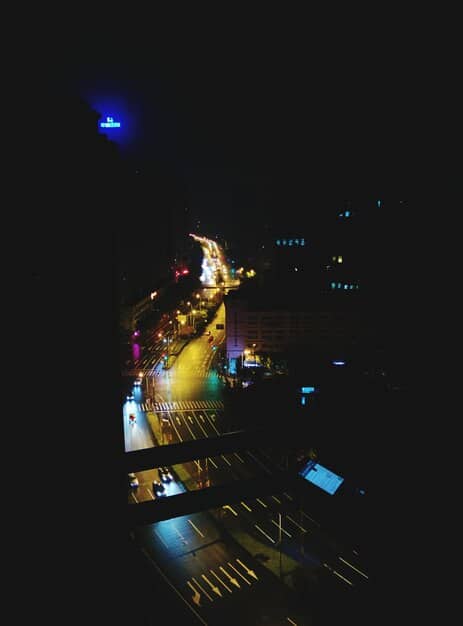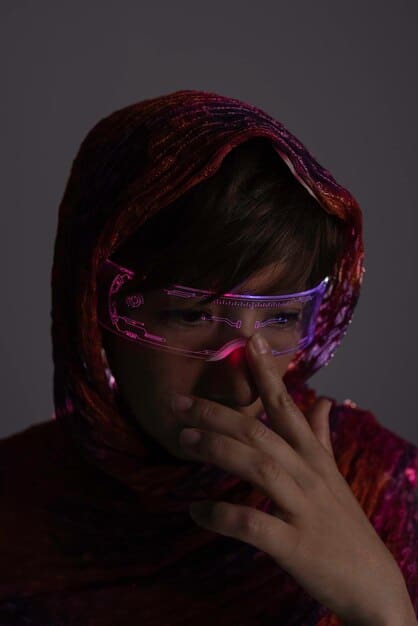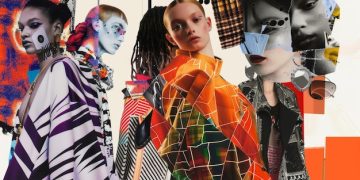Cyberpunk Realities: US Future and Leading Subcultures

Cyberpunk realities are increasingly visible in the US, driven by technological advancements, economic disparities, and influential subcultures like grinders, cybergoths, and biohackers, blurring the lines between fiction and reality.
The neon-lit, tech-saturated world of cyberpunk, once confined to the realms of science fiction, is increasingly reflecting the realities of modern-day America. But how close are we to a full-blown cyberpunk future, and which subcultures are leading the way?
Cyberpunk Aesthetics: Blurring Fiction and Reality
Cyberpunk, characterized by a blend of high-tech and low-life elements, presents a dystopian future where technology is ubiquitous but unevenly distributed. This potent mix has steadily seeped into our cultural consciousness, influencing fashion, art, and societal attitudes in the US.
Key Elements of Cyberpunk Aesthetics
Cyberpunk aesthetics go beyond mere visual appeal. They represent a deeper commentary on societal issues through stylistic choices.
- Neon and Urban Decay: The juxtaposition of bright neon lights against decaying cityscapes is a staple of cyberpunk, symbolizing both technological progress and urban decline.
- Cybernetic Enhancements: Artificial body parts and technological implants represent transhumanism and the blurring of human and machine.
- Punk Fashion: Rebellious clothing styles, such as leather jackets, ripped clothing, and unconventional hairstyles, reflect the anti-establishment ethos of the genre.
The Rise of DIY Cyberpunk
The DIY (Do-It-Yourself) movement has embraced cyberpunk aesthetics by creating personalized and accessible expressions of the genre.
- Modified Gadgets: Individuals modify existing technology to create unique, cyberpunk-inspired devices.
- Homemade Cybernetics: Some enthusiasts craft elaborate costumes and accessories that mimic cybernetic enhancements.
- Urban Exploration: Exploring abandoned or derelict urban environments provides a tangible connection to the dystopian settings of cyberpunk fiction.
Cyberpunk aesthetics are more than just a trend; they reflect a growing awareness of the societal issues that the genre explores. This DIY approach allows individuals to interact with the genre personally, creating a tangible link between fiction and reality. By embracing these aesthetics, people are actively shaping their environments, and adding to a redefinition of traditional concepts of art and technology.

High Tech, Low Life: Socioeconomic Parallels
The “high tech, low life” dichotomy inherent in cyberpunk is mirrored by the increasing socioeconomic divisions within the US. This divide fuels alienation and dissatisfaction, pushing individuals toward subcultures that resonate with cyberpunk’s themes.
The Widening Wealth Gap
The concentration of wealth in the hands of a few exacerbates inequality, reminiscent of the corporate-controlled dystopias often depicted in cyberpunk narratives.
Income inequality is a long-standing issue in the United States, but its effects have become even more acute in the 21st century. This economic imbalance aligns with the cyberpunk theme of corporations wielding disproportionate power, leaving ordinary citizens struggling to survive. As wealth concentrates at the top, the gap between the rich and the poor widens, creating a society where access to essential resources like healthcare, education, and housing becomes increasingly unequal.
Technological Unemployment
Automation and artificial intelligence threaten numerous jobs, leading to fears of widespread unemployment and a devalued workforce, echoing cyberpunk’s concerns about technology displacing human labor.
Technological advancement, while offering numerous benefits, also presents a challenge to the workforce. As automation and AI become more sophisticated, they begin to replace human workers in various industries. This technological unemployment leads to economic instability, as individuals find it increasingly difficult to secure stable, well-paying jobs. The fear of becoming obsolete in a rapidly changing job market is a significant concern, particularly for those in traditionally labor-intensive or routine task-oriented roles.
Corporate Influence on Government
The close ties between corporations and the government raise concerns about undue influence and a lack of accountability, mirroring the corrupt power structures in cyberpunk settings.
The interaction between corporations and government has come under scrutiny due to concerns about undue influence. Cyberpunk often portrays dystopian societies where corporations hold significant power over governments, shaping policies to benefit their interests. While the line between corporate lobbying and democratic governance can be fine, critics argue that excessive corporate influence leads to policies that favor corporate profits over public welfare. This can result in a society where the needs of ordinary citizens are secondary to the economic interests of a powerful elite.

Subcultures Leading the Charge: Grinders, Cybergoths, and Biohackers
Several subcultures in the US actively embody and advance the cyberpunk ethos. Grinders, cybergoths, and biohackers are prominent examples of groups pushing the boundaries of technology, identity, and social norms.
Grinders: The Cyborg Revolution
Grinders are individuals who embrace the integration of technology into their bodies, often through implants and modifications. They seek to enhance their physical and cognitive abilities, challenging traditional notions of humanity.
Grinders represent a radical approach to transhumanism, pursuing technological enhancements that blur the lines between human and machine. They often undergo surgical procedures to implant devices that monitor vital signs, interact with electronic systems, or augment sensory perceptions. This subculture challenges normative ideas about what is natural or acceptable, pushing the boundaries of human evolution through cybernetic integration. Grinders seek to redefine what it means to be human, embracing technology as a means to enhance their capabilities and overcome limitations.
Cybergoths: Industrial Dystopia Through Fashion
Cybergoths fuse industrial music and aesthetics with cyberpunk themes, creating a visually striking subculture that reflects a dystopian vision of the future. They employ bold fashion, incorporating elements like goggles, gas masks, and neon-colored hair.
Cybergoths create a visually striking expression of a dystopian future. They adopt bold fashion choices, mixing industrial and goth elements with cyberpunk aesthetics. This subculture thrives on electronic music, dance, and a sense of collective identification with a technologically mediated existence. Cybergoths use fashion, music, and lifestyle to challenge mainstream norms, subvert expectations, and create a unique sense of belonging in a world that often feels impersonal and alienating.
Biohackers: Democratizing Science
Biohackers are citizen scientists who conduct experiments and research outside traditional academic or corporate settings. They often focus on genetic engineering, DIY medicine, and open-source biology, seeking to democratize access to scientific knowledge and tools.
Biohackers promote the democratization of science, breaking down barriers to scientific research and making knowledge accessible to ordinary citizens. This subculture emphasizes collaboration, open-source knowledge, and hands-on experimentation, challenging the established hierarchies of traditional academic and corporate settings. Biohackers seek to empower individuals with the tools and information necessary to conduct their own research, fostering innovation, promoting scientific literacy, and contributing to a more equitable and accessible knowledge ecosystem.
Technological Advancements: Paving the Way
Rapid technological advancements are essential in creating a cyberpunk reality. From artificial intelligence to augmented reality, emerging technologies influence both our society’s capabilities and the potential for dystopian applications.
Artificial intelligence, augmented reality, and virtual reality are converging to shape a future increasingly reminiscent of cyberpunk visions. As these technologies become more sophisticated and deeply integrated into our daily lives, they offer new possibilities and raise complex ethical issues. The trajectory of these innovations will determine whether we move closer to a utopian or dystopian future.
Artificial Intelligence and Surveillance
AI-driven surveillance technologies raise concerns about privacy and control, reminiscent of the omnipresent monitoring systems depicted in cyberpunk scenarios.
- Facial Recognition: AI systems can identify individuals in real-time, potentially tracking their movements and activities.
- Data Collection: AI algorithms collect and analyze vast amounts of personal data, raising concerns about privacy violations and misuse.
- Algorithmic Bias: AI systems can perpetuate and amplify existing social biases, leading to unfair or discriminatory outcomes.
AI-driven surveillance raises questions about privacy, freedom, and social control. The widespread collection and analysis of personal data, combined with advanced surveillance technologies, create a panoptic environment where individuals are constantly monitored. The potential for abuse of these technologies represents a significant threat to privacy.
Augmented and Virtual Reality: Blurring Reality
AR and VR technologies create immersive experiences that blur the lines between the physical and digital worlds, influencing how we interact with information, entertainment, and each other.
- Immersive Gaming: AR and VR technologies provide realistic gaming experiences that simulate virtual worlds and scenarios.
- Virtual Workspaces: Remote collaboration and immersive productivity tools create new ways to work and interact in virtual environments.
- Social Interaction: Social VR platforms enable individuals to connect, communicate, and build relationships in shared virtual spaces.
AR and VR technologies are creating immersive experiences that change human interaction. These tools offer new approaches to education, entertainment, and social connectivity, pushing the boundaries of what is real and what is simulated. As AR and VR become more sophisticated, the line between the digital and physical worlds will continue to blur, impacting all aspects of human life.
Corporate Power and Influence: The New Megacorporations
The growing influence of corporations and the concentration of power in the hands of a few resemble the megacorporations depicted in cyberpunk fiction. These corporations influence policy, control resources, and shape societal norms.
- Lobbying and Political Influence: Corporations spend vast sums of money to influence government policies and regulations.
- Data Monopoly: Tech companies amass vast amounts of data, creating monopolies that control access to information and shape consumer behavior.
- Resource Control: Corporations dominate key industries, such as energy, finance, and technology, giving them significant control over essential resources.
Corporate power and influence pose a challenge to democratic governance and societal well-being. The ability of corporations to influence policies, control resources, and shape consumer behavior creates an uneven playing field. Ensuring a fair balance of power between corporations and citizens is essential for a just and equitable society.
The Human Cost: Mental Health and Well-being
The stresses of modern life, coupled with the technological advancements and socioeconomic disparities, take a toll on mental health and well-being. Cyberpunk reflects these struggles through characters grappling with alienation, anxiety, and existential dread.
Mental health and well-being in the 21st century are becoming increasingly important, compounded by the pressures of technological progress and social transformation. Navigating these challenges requires prioritizing self-care, seeking support when needed, and advocating for policies that promote societal well-being.
Alienation and Isolation
The breakdown of social connections and the rise of digital interactions lead to feelings of isolation and a lack of belonging.
- Digital Dependency: Heavy reliance on technology for communication and social interaction can weaken face-to-face relationships.
- Social Media: Constant exposure to curated online identities can contribute to feelings of inadequacy and social comparison.
- Urbanization: The density and anonymity of urban environments can lead to a sense of alienation and disconnect from community.
Alienation and isolation pose a significant threat to mental health and social cohesion. The decline of traditional social structures, combined with the rise of digital interactions, requires finding new ways to connect, build meaningful relationships, and foster a sense of belonging.
| Key Point | Brief Description |
|---|---|
| 💡Cyberpunk Aesthetics | Blend of high-tech and low-life visuals influencing fashion and art. |
| 💰Socioeconomic Parallels | Widening wealth gap and technological unemployment mirroring cyberpunk themes. |
| 🧬Grinders & Biohackers | Subcultures pushing boundaries of technology, identity, and bio-augmentation. |
| 🤖Corporate Influence | Corporations dominating policies and shaping societal norms. |
Frequently Asked Questions
Cyberpunk reflects a growing awareness of the societal issues that the genre explores. It also shows how people are starting to shape their environments by redefining traditional concepts of art and technology.
Frequently Asked Questions
▼
The US exhibits several traits of a cyberpunk future, including increasing economic inequality and the prevalence of technological advancements used for both innovation and surveillance.
▼
Grinders, cybergoths, and biohackers are key subcultures embodying cyberpunk themes through technological integration, dystopian aesthetics, and democratized science.
▼
Corporations play a major role by influencing policies, controlling resources, and shaping societal norms, resembling the megacorporations depicted in cyberpunk fiction.
▼
AI and augmented reality contribute to immersive experiences that blur the line between the physical and digital worlds, thereby influencing how we interact.
▼
The stresses of modern life, coupled with technology and socioeconomic disparities leads to alienation, anxiety, and existential dread.
Conclusion
The convergence of technological progress, socioeconomic divisions, and subcultural innovation is increasingly shaping the United States into a landscape that echoes cyberpunk fiction. While the future remains unwritten, understanding these trends provides valuable insights into the evolving relationship between humanity and technology in the 21st century.





